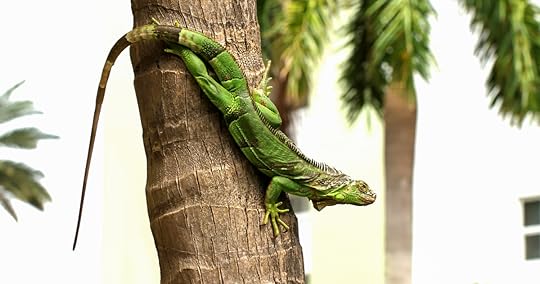Ripley Entertainment Inc.'s Blog, page 103
February 9, 2022
How Pepsi Came To Own A Soviet Naval Fleet
Featured in Ripley's Believe It or Not!

When one thinks of Russia’s favorite drink, vodka comes to mind. But what if another, softer drink captivated the hearts of the Soviet Union? In one of the craziest business deals in history, Russia sold Pepsi an entire military arsenal of vehicles to satisfy their craving for the popular soda, making them the sixth-largest naval fleet in the world.
Love at First SipIt all started at the American National Exhibit in Moscow in 1959 when then-president Richard Nixon and Soviet leader Nikita Khrushchev became locked in the infamous Kitchen Debate, an argument about the perks of capitalism versus communism. To cool down the heated discussion, Donald Kendall, the head of Pepsi’s international division, told Nixon to offer Khrushchev a taste of the fruits of capitalism’s labor: Pepsi.
It was love at first sip for Khrushchev, who urged his comrades to join him in trying the tasty beverage.
Embed from Getty Imageswindow.gie=window.gie||function(c){(gie.q=gie.q||[]).push(c)};gie(function(){gie.widgets.load({id:'Fb2-QQqcRjtQe-B-LLJkpg',sig:'f0QvLwK5QYFvDHG8c3arWb9fu44V-iBPI8O5zV1AvZU=',w:'594px',h:'592px',items:'514705242',caption: true ,tld:'com',is360: false })});
Donald Kendall’s Soda SchemeKendall was taking a risk having Pepsi appear at the American National Exhibit. Higher-ups thought the effort was a waste of time and money. Kendall told Nixon that he “had to get a Pepsi in Khrushchev’s hand” to preserve his reputation.
Kendall’s fizzy gamble paid off, using the PR success from the exhibit to become Pepsi CEO in 1963. Now in the captain’s chair, Kendall had a primary focus on finally bringing that sweet sugary goodness to the Soviet Union.
The Barter System ReturnsDespite Khrushchev’s immediate love for the American beverage, it took several years and a lot of negotiating until all of Russia could share a Pepsi with their comrades in 1972.
Getting Pepsi into the country wasn’t a smooth transaction. Since the Soviet ruble had no value outside of Russia, both parties had to resort to more traditional bartering methods to reach a deal. In exchange for every bottle of Pepsi sold, Russia would provide the soda giant with an equal amount of Stolichnaya vodka to resell in the U.S.
While Russians enjoyed slurping up the American delicacy, Pepsi reaped recognition as the first capitalist product to break through the Iron Curtain.
Embed from Getty Imageswindow.gie=window.gie||function(c){(gie.q=gie.q||[]).push(c)};gie(function(){gie.widgets.load({id:'nUUnX4XCSmtxVMYb8UflZw',sig:'fYImHRG6U_RnXyAABdOhZIE2zrLGYiAlQFeWsGzkeXA=',w:'594px',h:'397px',items:'515142038',caption: true ,tld:'com',is360: false })});
By the late 1980s, Pepsi realized that Russia’s soda consumption far outpaced the power of the American boozehound. Combined with a lack of sales due to Americans protesting the Soviet-Afghan war, they had a surplus of vodka and a shortage of cold hard cash.
With an untransferable currency and now vodka off the table, Russia was scrambling for a new way to satisfy its bubbly appetite. However, there was one outrageous option: using the country’s abundance of military vehicles to win the battle of thirst.
A Force to be Reckoned With?In a bizarre agreement, Russia sold Pepsi 17 submarines, a frigate, a cruiser, and a destroyer in 1989 to keep soda flowing into its citizens’ mouths. With all this firepower, Pepsi indirectly became the sixth largest naval fleet in the world.
Embed from Getty Imageswindow.gie=window.gie||function(c){(gie.q=gie.q||[]).push(c)};gie(function(){gie.widgets.load({id:'7LSOXJFDQg1-Gyl4WaBDLw',sig:'T35p7tuVcyOH8TQY9KUDEZt-5ribpcYLGU1TKp5QObM=',w:'594px',h:'384px',items:'522573952',caption: true ,tld:'com',is360: false })});
Their reign didn’t last long, though. Rather than using the newly acquired fleet (made up of obsolete vessels) to take their epic war with Coca-Cola from the shelves to the seas, Pepsi sold it off as scrap metal. (Guess we know why Pepsi doesn’t have any iron in it.)
Kendall was aware of the irony of Russia handing a U.S. corporation a military fleet, telling national security advisor Brent Scowcroft he was “disarming the Soviet Union faster than you are.”
A year later, Kendall arranged the “Deal of the Century,” where the USSR would build Pepsi 10 oil tankers to pay for three billion dollars’ worth of Pepsi.
Everything Fizzles Out EventuallyUnfortunately for Pepsi, the fall of the Soviet Union in 1991 made it a lot harder for the capitalist soda giant to conduct business in Russia. Kendall struggled to make new business deals with the new Republics in town.
Embed from Getty Imageswindow.gie=window.gie||function(c){(gie.q=gie.q||[]).push(c)};gie(function(){gie.widgets.load({id:'qy0knr48QBd22DqyfoImWw',sig:'7XwLxPcZCAAVauIkVh_0p_zFWU6jet1WIlgVoXhseCw=',w:'594px',h:'399px',items:'956602084',caption: true ,tld:'com',is360: false })});
Redrawn borders also divided the pop powerhouse’s vital assets. Their oil tankers were being built in Ukraine (who wanted a cut of that sweet American soda money), while their bottling plant was in Belarus. Pepsi’s dealings in Russia ultimately exploded like a shaken up can of soda.
Pepsi’s glory days with Russia have since fizzled out, following Coca-Cola’s fast break into the country during the Moscow Olympic Games in 1980. Still, Pepsi can treasure when, if only for a split second, they were the apple — nay, soda — of Russia’s eye, and the most powerful soda company on the planet.
By James Whelan, contributor for Ripleys.com
EXPLORE THE ODD IN PERSON! Discover hundreds of strange and unusual artifacts and get hands-on with unbelievable interactives when you visit a Ripley’s Odditorium!CARTOON 02-09-2022
February 8, 2022
Who’s To Blame For Shrinking Feline Brains?
Featured in Ripley's Believe It or Not!

What comes to mind when you hear the term “headshrinker?” Perhaps psychologists and psychiatrists? Or maybe you think about groups like the Jivaro of northwestern Amazonia who, not so long ago, shrunk and preserved human heads as tsantas?
Whatever your first thought, we’d wager it doesn’t involve a good hard look in the mirror. But according to the latest scientific research, that’s exactly what you (and every other human being) should do. Especially if you’re a cat owner.
You see, new research demonstrates that humans have been busy inadvertently shrinking feline brains for at least the past 10,000 years. Keep reading to learn more about our accidental role in diminishing cat craniums and what it means for our feline friends.
Domestic Felines Versus Their Feral CounterpartsWhat happens when you compare the cranial measurements of domesticated cats with those of their closest feral cousins? That’s the question a group of researchers led by Raffaela Lesch, Ph.D., at the University of Vienna wanted to explore. So, they did A LOT of head measuring, both of domestic cats and their closest wild relatives from Africa and Europe. Since cranium size indicates brain size, their data gathering remained happily unobtrusive to their subjects.

Through this research published by the Royal Society, Lesch and the team hoped to gain new insights into how millennia of domestication have impacted the morphology of house cats. And they also wished to better understand how breeding between domestic animals and wild ones might affect conservation efforts and survivability rates. Although scientists have long understood that domesticity impacts brain size, the teams’ findings still proved remarkable.
Ten Thousand Years of Shrinkage ShowsDomesticated felines have seen significant cranial shrinkage over the past ten thousand or so years. In some cases, it amounts to 25 percent smaller skulls and brains than their wild peerage. Sorry, Garfield! The researchers also found that in cases where wild and domesticated cats breed, the cranial measurements of their offspring fall smack-dab in the middle. In other words, the viability of these kittens may be diminished, especially if forced to make their way into the wild.
Lesch and the team’s findings support an expanding body of research showing that domestication is a major driver of physiological adaptation over time. The researchers noted, “Changes to cranial volume have been well documented across [domesticated] species, including sheep, rabbits, dogs, and many more.”

But why shrinkage? Researchers believe it relates to selection for tameness in the domesticated animals, resulting in fewer brain cells associated with migration, fear, excitability, and other key characteristics related to life in the wild. These changes to stress response might manifest in physical ways over time. . . like smaller brains.
Underestimate Felines at Your Own RiskThat said, don’t assume that just because your domestic cat’s brain is smaller, they’re any less clever than their wild ancestors. Morphological changes to head size indicate characteristics like domesticity have taken precedence over others like hunting. But if you’re a cat owner, you can rest assured your furry friend is still the cat’s meow. And while you might be the headshrinker in your feline’s life, know they’re returning the favor.
Doctor of Veterinary Medicine Ellen Lindell notes, “As humans, we agree to be trained [by our cats]. We do things that our cats want because it’s part of a relationship that benefits us both. It’s a give-and-take relationship — a friendship between two different creatures.” In other words, cats may be impacting our brains, too. But who’s measuring?
By Engrid Barnett, contributor for Ripleys.com
EXPLORE THE ODD IN PERSON! Discover hundreds of strange and unusual artifacts and get hands-on with unbelievable interactives when you visit a Ripley’s Odditorium!CARTOON 02-08-2022
February 7, 2022
CARTOON 02-07-2022
February 6, 2022
CARTOON 02-06-2022
February 5, 2022
CARTOON 02-05-2022
February 4, 2022
Freezing Florida Temps Knock Iguanas From Trees
Featured in Ripley's Believe It or Not!

Tourists flocking to Florida in search of a reprieve from last weekend’s bombogenesis storm in the Northeast (and regular old winter in the Midwest) arrived only to find temperatures so cold frozen iguanas were falling out of trees.
It’s not often that temperatures drop below 40 degrees in the Sunshine State. Still, when the cold weather moves in, it snaps with the force of Thanos, leaving Floridians and their animal cohabitants scrambling for shelter and warmth.
Last weekend was no exception, as temperatures across the state dropped into the 20s in some areas, with even cities as far south as West Palm Beach experiencing a low of 37 degrees Fahrenheit — the coldest it’s been in over a decade. At Ripley’s headquarters in Orlando, we bundled up to brave bitter a couple of 30-degree mornings, matching our record low from 1966.
While the weather wasn’t chilly enough to cause a snowstorm or damage precious strawberry crops, it did send a shock to invasive neighbors in the south — the iguana population.
Accustomed to the warmer things in life, iguanas have no chill when faced with the threat of dropping temperatures, going into a sort of catatonic state before falling to the ground. Don’t worry, though! The dramatic dragons come back to life as soon as their preferred climate returns.
Animals Keep on Falling
In Florida, immobilized iguanas are falling from trees due to cold weather conditions https://t.co/wPtXvCsAuV pic.twitter.com/7OiMSqpcko
— Reuters (@Reuters) January 31, 2022
While it’s not quite literally raining iguanas in Florida, there have been strange cases where other animals have indeed fallen from the sky in a rare phenomenon called, you guessed it, “animal rain.”
In early January, a sea of fish was swept into the Texas skies before splattering back down to Earth in the town of Texarkana.
Frogs are a more common victim of the waterspout wonder, much to the delight of neighborhood cats that feast on the ribbiting raindrops.
Florida Says “No Thanks” to Punxsutawney PhilPunxsutawney Phil may have predicted six more weeks of winter Wednesday morning, but it appears that Florida has other plans. As the country faces another wave of winter weather this weekend, Florida has officially decided not to participate this time around, with temperatures already back to their balmy and beachy 80 degrees.
As we thaw out and celebrate making it through Florida’s three-day winter season with t-shirts and memes, we invite you to send any videos of friends and family being pelted by falling iguanas our way!
By Meghan Yani, contributor for Ripleys.com
EXPLORE THE ODD IN PERSON! Discover hundreds of strange and unusual artifacts and get hands-on with unbelievable interactives when you visit a Ripley’s Odditorium!CARTOON 02-04-2022
February 3, 2022
The Golden Age Pineapple Rentals
Featured in Ripley's Believe It or Not!

The pineapple is in the running for the quirkiest-looking fruit around, and it can certainly be tricky to prepare. It’s worth the effort of penetrating that armored shell, though: pineapple is rich in fiber, vitamin C, and manganese, and boasts a sharp taste with a real kick. While enjoying it, though, try not to think about the fact that it’s actually digesting you, too!
Today, pineapples can be found quite easily at the average store or market – just your typical grocery item. However, this wasn’t always the case. There was once a time when people had to get in line for the tasty treat and take out a rental to have it in their possession!
Christopher Columbus Introduces the Incredible Pineapple to Europe

Christopher Columbus, it seems, brought the first pineapples to Europe (Spain, specifically), having found this delicacy in the Caribbean, in Guadeloupe, in the early 1490s. It became the talk of the continent, and its incredible rarity and exotic nature soon elevated it far beyond the rank of a mere foodstuff. It became a symbol of status.
Brits, too, were desperate to get in on the spiny-fruit action. The pineapple reportedly made it to British shores in the 1600s, and, like any scarce commodity, it attracted extravagant prices. One pineapple would have cost around $8,000 in today’s standard!
This hefty price tag meant that Stuart England and the British Isles had little hope of ever buying a pineapple of their very own. They were essentially fascinating curios, like something to be enthusiastically ogled in a museum. Astonishing as it is, this isn’t far from the way that the prickly fruit was treated.
One of The Quirkiest Accessories of All TimeEmbed from Getty Imageswindow.gie=window.gie||function(c){(gie.q=gie.q||[]).push(c)};gie(function(){gie.widgets.load({id:'1oL6GgtfSwJhgHRpLMr-2Q',sig:'1TKUJMK2XfI2CFEGCOulnKFREQOnYNAfoXYrQ09kOpw=',w:'594px',h:'407px',items:'830388494',caption: true ,tld:'com',is360: false })});
Few people in Britain, if anybody at all, could afford to purchase pineapples as part of their everyday fruit-eating routine. Even if they could, the precious commodity was far too important to even consider wasting in such a fashion. The people were proud to parade their social status, or otherwise imitate those with the wealth to do so. The result of this was a tremendous rise in “status” pineapples and pineapple leasing.
Those who couldn’t afford this fruity luxury could rent them, instead! They became the ultimate talking point at a private function where guests needed to be impressed. It was all about keeping up with the Joneses, and if the Joneses happened to have a pineapple, you had to have one too — at least temporarily.
While wealth-flaunting and status-chasing had been all too common, there were some pineapple lovers who had no need to pretend. King Charles II was a huge fan of the exotic foodstuff. He reportedly had a portrait made of himself which depicts John Rose, the royal gardener, handing the stately king a pineapple with a look of reverence on his face. Reverence for the king, or for the king’s pineapple? Surely, both.
Embed from Getty Imageswindow.gie=window.gie||function(c){(gie.q=gie.q||[]).push(c)};gie(function(){gie.widgets.load({id:'5-qsmQhHTfZpaF31EklWrg',sig:'VaryTU2O1h2xUEHohbPgBmylxkzhtWdirdeIvefnLVg=',w:'594px',h:'509px',items:'804448324',caption: true ,tld:'com',is360: false })});
Later in the 1700s, pineapples were featured in literature and the arts. Sanditon, a novel that the much-acclaimed Jane Austen didn’t finish, featured a lavish meal hosted by a socialite named Lady Denham. There, among the finery and upper-class cuisine, was a pineapple, just as it would have appeared at real occasions of such grandeur at the time.
There was more to the great pineapple enthusiasm than simply renting them or displaying them proudly – until they became too rotten to do so. In Britain’s cold and rainy climate, it was a tremendous task to grow the fruit itself, but people did manage!
The Rise Of “Pineries” In EnglandKing Charles II’s famous pineapple, in fact, was said to be the first grown on English soil, though how much of a cheat to impress the king this was (or wasn’t) remains unknown. What is for certain, however, is that native pineapples did become a reality.
Pineries, as they came to be known, were created at Hampton Court for William of Orange in the late 1680s. Basically greenhouses, their glass construction allowed for sufficient light and warmth needed in the less-than-tropical European climate.

Nonetheless, it was a painstaking process. Three years are needed for a pineapple to flower, and yields are very low. All of this, naturally, only made the precious plant more valuable, and its fruit more expensive. By the time of Victorian Britain, prices were somewhat more manageable for pineapple growers, but the practice was still very expensive.
Today, pineapples are eaten regularly around the world. In colder climates, they are often considered exotic or tropical, but certainly not to the extent that they used to be!
By Chris Littlechild, contributor for Ripleys.com
EXPLORE THE ODD IN PERSON! Discover hundreds of strange and unusual artifacts and get hands-on with unbelievable interactives when you visit a Ripley’s Odditorium!Source: The Golden Age Pineapple Rentals
Ripley Entertainment Inc.'s Blog
- Ripley Entertainment Inc.'s profile
- 52 followers









